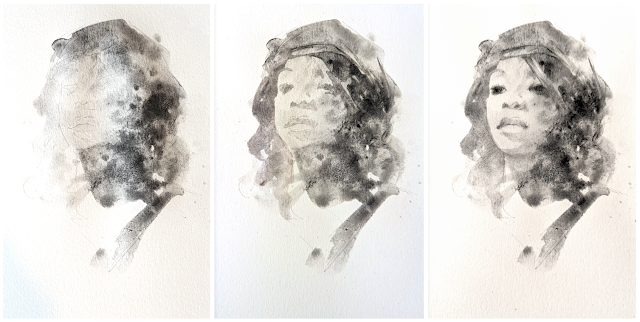by Lisa Larrabee
Charcoal is both bold and forgiving. You can blend and smudge charcoal or sharpen it to draw with precision. Charcoal is a staple in most drawing classes, but did you know that you can also paint with it?
If you mix charcoal powder with water, you can paint using a process that is similar to watercolor. The charcoal powder often pools and settles creating interesting patterns as it dries. When the water evaporates, all that is left on the paper is the charcoal. This charcoal can now be manipulated using traditional dry charcoal techniques. You can blend, erase and add details using blending stumps, charcoal sticks and charcoal pencils.
Wet & Dry Charcoal Techniques
In this demo, I started with a light pencil drawing to indicate the main value shapes. The initial wash of charcoal powder and water was very diluted. A little charcoal goes a long way. It can be easier to add value than it can be to take it away. While the wash was wet, I dropped in darker puddles on the shadow side and spattered some spontaneous drops.
The second layer was added after the first layer was dry. In a method similar to watercolor, painting wet over dry allows more control over the new layer because the shapes will not bleed the way that they would if applied over wet areas. In this layer, I specifically painted darker values and shadow shapes. The charcoal mixture was again heavily diluted with water. Keep in mind that additional painted layers can easily disrupt the charcoal painted underneath because there isn't any binder added. Although the application can be similar to painting with watercolor or ink, it has it's own unique challenges.
I have found it easier to add details and darker values using dry charcoal drawing techniques. Once the paper was completely dry, I could use a blending stump to blur and soften transitions. I used a kneaded eraser to lift out a few highlights. Because I intentionally kept the values in the face a bit light, I did not need to erase much. Sometimes the darker values can be stubborn to lift, so it is easier to build up darker details gradually with a sharp charcoal pencil.
The loose application of charcoal washes can feel a bit out of control. Try to let go during this stage knowing that you can regain control with more precise drawing tools (charcoal pencils, blending stumps and erasers). The wet stage is an opportunity for happy accidents. Let the charcoal puddle or bloom in ways that only it can. When you switch to more precise drawing tools, remember to respond to the charcoal washes rather than try to control them after the fact. Embrace the expressive qualities that are possible when you let go.
Art Challenge
Here's a challenge to help you practice.
- Choose a subject to draw with clear light and dark value shapes. A subject like a tree or flower is more forgiving to experiment with than the more structured form of a portrait.
- Mix a little charcoal powder and water in a small container. It can take some time to fully stir in the charcoal. You can purchase charcoal powder to use wet or dry or make your own with sandpaper and a stick of charcoal. A little can go a long way.
- A watercolor pallet can be useful for creating various mixtures ranging from inky black to lighter values that are diluted with water.
- Allow yourself to play, experiment, spatter, spray water, etc. The looseness of the charcoal washes provide great contrast to more controlled layers.
- Paint additional layers or switch directly to dry charcoal techniques. Painting layers with charcoal has it's own unique challenges. Give yourself time to experiment and find solutions that work for you.
- Use dry charcoal techniques to add details in response to the washes. The goal is not to make an accurate copy of the subject, but to allow for spontaneity and expressive, fluid marks.




